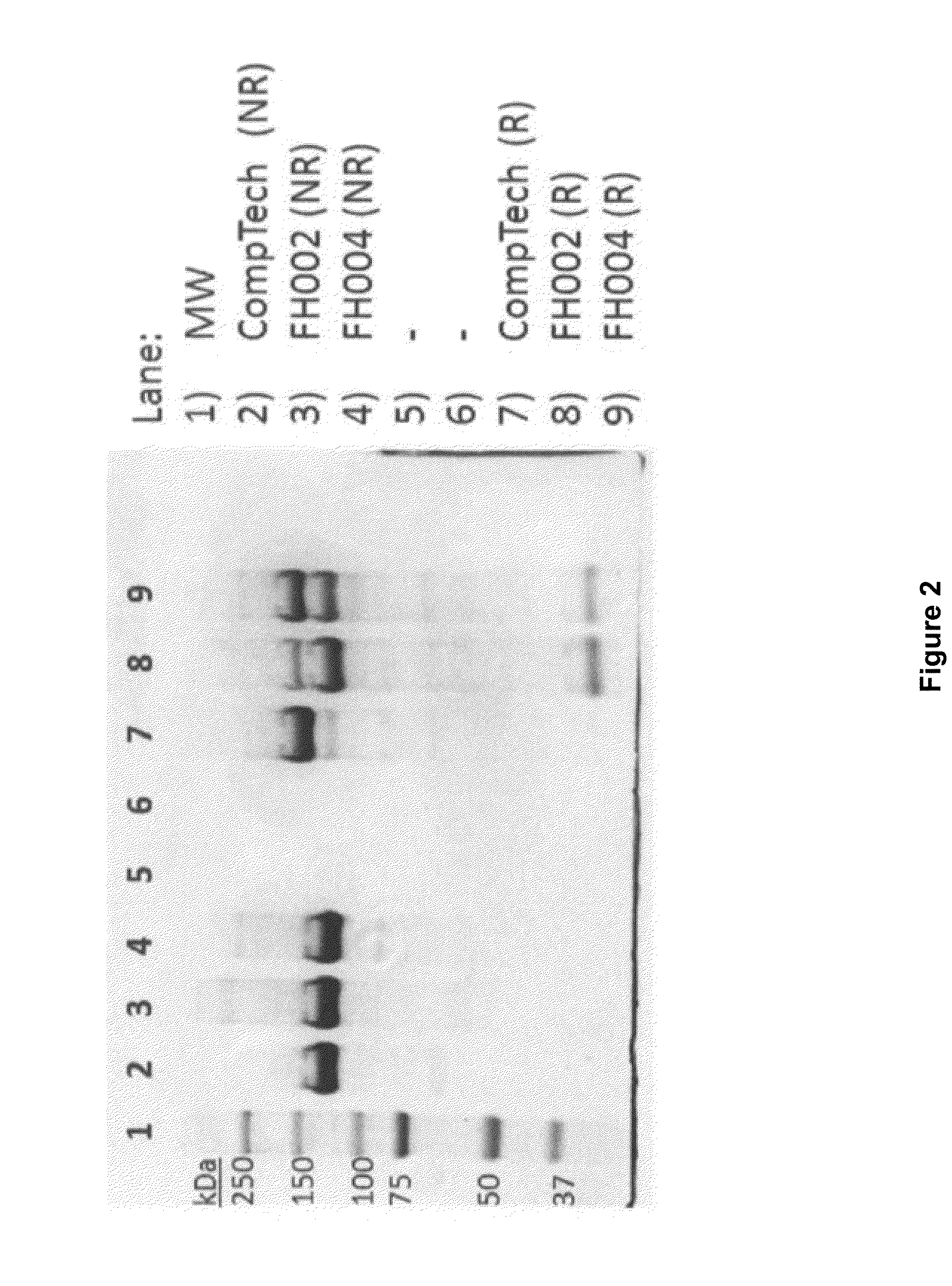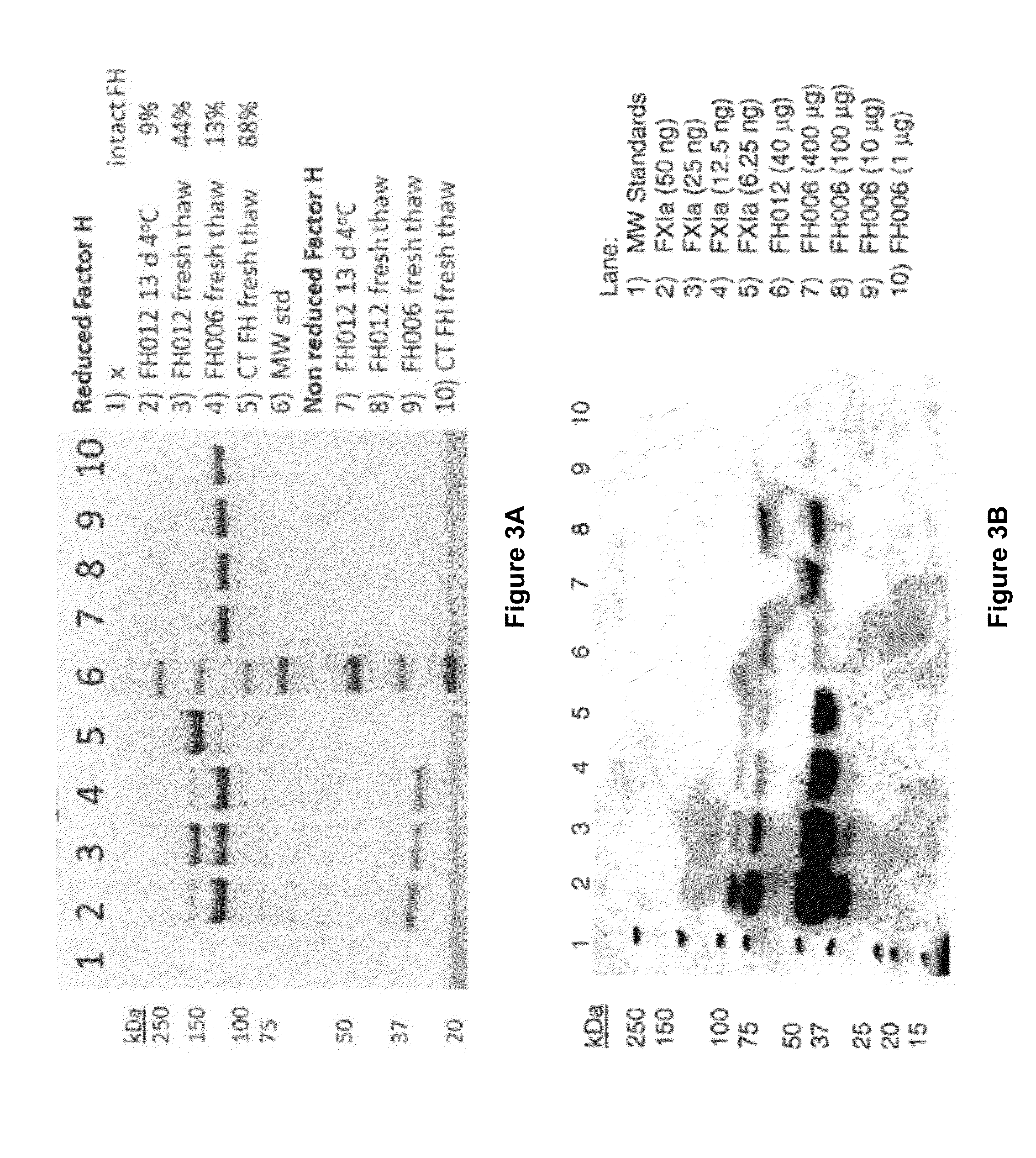Isolation of factor h from fraction i paste
a fraction i paste and factor h technology, applied in the field of fraction i paste isolation, can solve the problems that the strategy was not amenable to enrichment of factor h, and achieve the effect of lowering the level of amidolytic activity
- Summary
- Abstract
- Description
- Claims
- Application Information
AI Technical Summary
Benefits of technology
Problems solved by technology
Method used
Image
Examples
example 1
Purification of Factor H from Cohn Fraction II+III Silicon Dioxide Filter Cake
[0180]As reported in U.S. Pat. No. 8,304,524, Factor H can be purified from Cohn Fraction II+III silicon dioxide filter cake, a byproduct of the process used to manufacture pooled human immunoglobulin G compositions. The method used for Factor H purifications from Cohn Fraction II+III silicon dioxide filter cake in U.S. Pat. No. 8,304,524 is outlined as method 100 in FIG. 1. Briefly, method 100 includes: dissolving (102) the filter cake to extract Factor H, reducing the conductivity (102) of the dissolved solution, centrifuging and filtering (106) to clarify the dissolved solution, enriching Factor H (108) by DEAE anion exchange chromatography, reducing the conductivity (110) of the DEAE eluate, and enriching Factor H (112) by heparin affinity chromatography.
example 2
Stability Characterization of Factor H Purified from Fraction II+III Silicon Dioxide Filter Cake
[0181]During the purification of Factor H from Cohn Fraction II+III silicon dioxide filter cake, as described in Example 1, it was noticed that under reducing conditions, e.g., conditions that eliminate disulfide bonds, purified Factor H resolved as two major bands during SDS-PAGE analysis, suggesting that Factor H was being proteolytically clipped (e.g., the Factor H polypeptide backbone was being broken at a discreet location). Due to the extensive network of disulfide bonds that stabilize the tertiary structure of Factor H, this proteolytic clipping was not observed under non-reducing conditions.
[0182]For example, the SDS-PAGE gel reproduced in FIG. 2 shows that under non-reducing condition (NR), the migration pattern of Factor H purified from Cohn Fraction II+III silicon dioxide filter cake (FH002 and FH004), as described in Example 1, is indistinguishable from the migration pattern o...
example 3
Characterization of Proteolytic Activity in Factor H Compositions Purified from Fraction II+III Silicon Dioxide Filter Cake
[0183]The source of the observed proteolytic clipping of Factor H in compositions enriched from Cohn Fraction II+III silicon dioxide filter cake was further investigated. An experiment testing the stability of Factor H upon incubation at 4° C. for an extended time demonstrated that Factor H compositions purified from Cohn Fraction II+III silicon dioxide filter cake (lots FH002 and FH004), as described in Example 1, contained proteolytic activities. Briefly, an aliquot of Factor H isolated from Cohn Fraction II+III silicon dioxide filter cake (lot FH012) was incubated for 13 days at 4° C. The structure of the incubated Factor H (FH12 13 d 4° C., lane 2) is compared in FIG. 3A to the structure of: Factor H from the same purification lot (FH012 fresh thaw, lane 3); Factor H from an equivalent lot purified from Cohn Fraction II+III silicon dioxide filter cake (FH006...
PUM
| Property | Measurement | Unit |
|---|---|---|
| conductivity | aaaaa | aaaaa |
| conductivity | aaaaa | aaaaa |
| conductivity | aaaaa | aaaaa |
Abstract
Description
Claims
Application Information
 Login to View More
Login to View More - R&D
- Intellectual Property
- Life Sciences
- Materials
- Tech Scout
- Unparalleled Data Quality
- Higher Quality Content
- 60% Fewer Hallucinations
Browse by: Latest US Patents, China's latest patents, Technical Efficacy Thesaurus, Application Domain, Technology Topic, Popular Technical Reports.
© 2025 PatSnap. All rights reserved.Legal|Privacy policy|Modern Slavery Act Transparency Statement|Sitemap|About US| Contact US: help@patsnap.com



